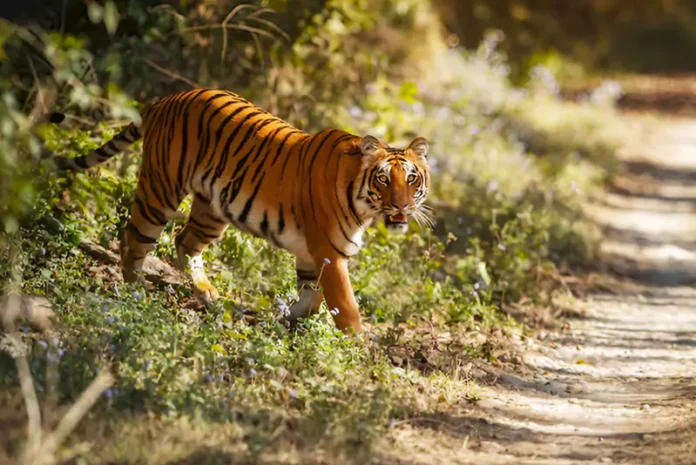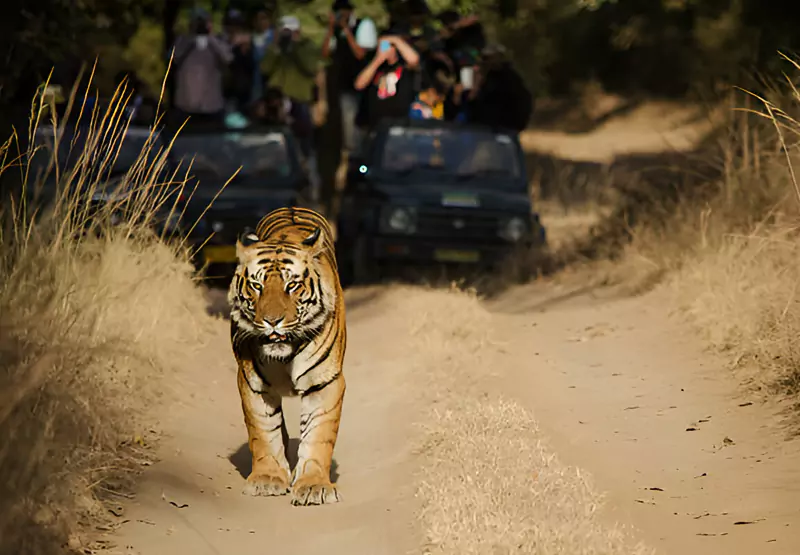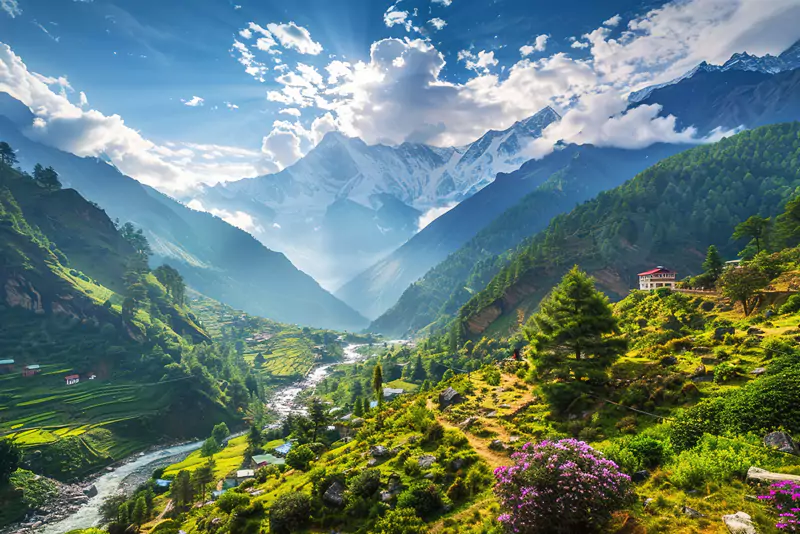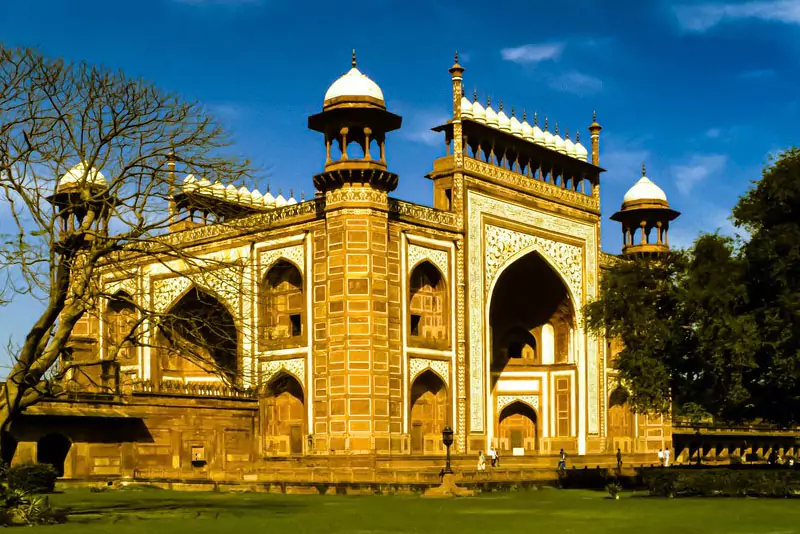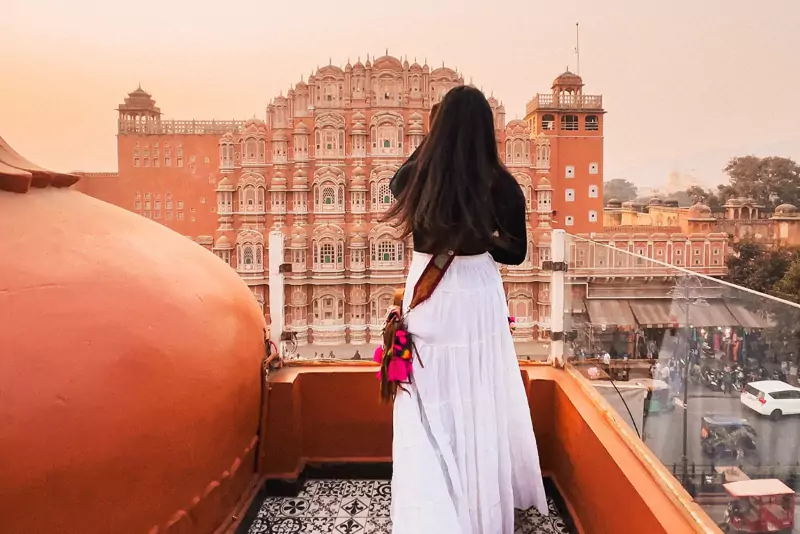Often referred to as the “Heart of India,” Madhya Pradesh is known for its rich biodiversity and stunning natural landscapes. Home to 11 national parks, the state offers a variety of ecosystems and a wide range of unique wildlife species.
Key Highlights:
From dense forests to open grasslands, Madhya Pradesh’s national parks are havens for wildlife. Visitors can spot majestic Bengal tigers, leopards, barasinghas (swamp deer), and hundreds of bird species in their natural habitats. These parks not only play a crucial role in the conservation of endangered species but also promote eco-tourism, supporting both environmental preservation and local livelihoods.
1. Bandhavgarh National Park: A Premier Wildlife Destination in Madhya Pradesh
Bandhavgarh National Park is one of the most famous and tiger-rich reserves in India. Known for having the highest density of Bengal tigers, it offers thrilling wildlife safaris where travelers can also spot leopards, chitals, sambars, nilgais, and over 250 species of birds.
Set against a backdrop of lush forests and ancient ruins, Bandhavgarh appeals not only to wildlife enthusiasts but also to those interested in history and nature. Whether you’re seeking a glimpse of a majestic tiger or exploring remnants of old forts hidden in the jungle, this park promises an unforgettable adventure.
2. Kanha National Park: A Wild Paradise That Inspired The Jungle Book
Kanha National Park, nestled in the heart of Madhya Pradesh, is one of India’s most spectacular and celebrated wildlife reserves. Its enchanting forests and vibrant landscapes served as the inspiration for Rudyard Kipling’s classic tale The Jungle Book.
The park is renowned for its lush green valleys, dense sal forests, and wide open meadows—creating an ideal haven for diverse wildlife. Among its most treasured inhabitants is the rare hard ground barasingha (swamp deer), affectionately known as the “Jewel of Kanha.”
Wildlife enthusiasts can also spot majestic Bengal tigers, leopards, Indian gaurs (bison), barking deer, and a rich variety of bird species. With its mesmerizing beauty and thriving biodiversity, Kanha is a must-visit for nature lovers, photographers, and anyone seeking a true jungle adventure.
3. Dinosaur Fossil National Park, Dhar
Located in the Dhar district of Madhya Pradesh, the Dinosaur Fossil National Park is a unique and historically significant site that offers a glimpse into Earth’s prehistoric past. It is one of the rare places in India where visitors can see real fossil remains of dinosaurs that roamed the planet millions of years ago.
The park features well-preserved fossil sites and offers an exciting introduction to the science of paleontology. Ideal for history buffs, geology enthusiasts, and curious travelers, this national park combines education with adventure, making it a fascinating stop for all age groups.
4. Ghughua Fossil National Park, Dindori
Situated near Shahpura in the Dindori district, Ghughua Fossil National Park is a rare and scientifically important destination in Madhya Pradesh. The park is famous for its extensive collection of plant fossils dating back nearly 65 million years to the Jurassic era.
Visitors can explore fossils of ancient tree trunks, leaves, and seeds preserved in the rocks and soil. This park serves as an open-air laboratory for those interested in paleobotany and natural history, attracting researchers, students, and nature enthusiasts alike.
Ghughua not only uncovers the ecological past of Madhya Pradesh but also offers a thrilling look at the Earth’s evolution and prehistoric life.
5. Kuno National Park – The New Home of Cheetahs in India
Kuno National Park, spread across the Sheopur and Morena districts of Madhya Pradesh, is a thriving wildlife sanctuary known for its rich biodiversity. Originally declared a wildlife sanctuary in 1981, it was later upgraded to national park status. It has recently gained global attention as the site of India’s ambitious Cheetah Reintroduction Project, welcoming African cheetahs back to Indian soil after 70 years.
This park is home to a variety of predators, including the Indian leopard, Southeast African cheetah, jungle cat, sloth bear, dhole (Indian wild dog), wolf, jackal, hyena, and fox. Among herbivores, visitors can spot species like chital, sambar, nilgai, four-horned antelope, chinkara, blackbuck, and wild boar.
Kuno’s mixed forests, open grasslands, and small rivers create an ideal habitat for wildlife and an emerging hotspot for eco-tourism, safaris, and wildlife photography. It is a must-visit for anyone interested in conservation and wilderness adventures.
6. Madhav National Park – Scenic Wildlife & Lakeside Views
Nestled in the Vindhya Hills of Gwalior district, Madhav National Park offers a picturesque natural setting once used as a royal hunting ground by the Scindia dynasty. Today, it stands as a protected sanctuary celebrating nature and wildlife conservation.
The park’s diverse terrain includes grasslands and forested areas that are home to herbivores like chital, sambar, nilgai, and barasingha, as well as predators such as leopards and sloth bears. It is also a paradise for bird watchers, with several rare and migratory bird species found here.
What sets Madhav apart are its two stunning lakes—Madhav Sagar and Sakhya Sagar—which enhance the park’s charm. These lakes offer beautiful sunrise and sunset views, accompanied by the sights and sounds of water birds and tranquil waterscapes.
Ideal for wildlife enthusiasts, photographers, and those seeking peace in nature, Madhav National Park is a serene and rewarding escape in central India.
7. Panna National Park – A Remarkable Tiger Conservation Success Story
Panna National Park, spread across the Panna and Chhatarpur districts of Madhya Pradesh, is one of India’s prominent tiger reserves. Set along the scenic Ken River, the park is renowned for its successful tiger reintroduction program, earning acclaim both nationally and internationally.
Once on the brink of losing its tiger population, Panna has seen a dramatic revival through careful relocation and conservation efforts. Today, it is home to a growing number of Bengal tigers, as well as leopards, wolves, jungle cats, chital, sambar deer, nilgai, chinkara, and blackbuck.
Bird lovers will find the park equally captivating, with over 200 species recorded, including Indian vultures, fish eagles, and flamingos.
Panna’s varied terrain of plateaus, deep valleys, and dense forests provides stunning opportunities for wildlife photography and open jeep safaris. A unique experience here is the boat safari along the Ken River, where you may spot crocodiles and other aquatic species in their natural setting.
8. Pench National Park – The Living Legacy of The Jungle Book
Straddling the border of Madhya Pradesh and Maharashtra, Pench National Park is a vibrant wildlife sanctuary best known as the inspiration behind Rudyard Kipling’s The Jungle Book. With its lush forests, undulating hills, and teeming wildlife, Pench offers a truly immersive jungle experience.
The park is home to majestic Bengal tigers, leopards, dholes (wild dogs), sloth bears, Indian gaurs (bison), and herds of deer including chital and sambar. Its healthy population of herbivores like nilgai, chinkara, and wild boars supports a dynamic predator-prey ecosystem.
Birdwatchers will be thrilled by the 285+ species of birds found here, including peacocks, owls, hawks, sarus cranes, and numerous migratory birds.
The safari experience in Pench is exhilarating—open jeep rides often bring surprise encounters with elusive big cats. Flowing through the heart of the park is the Pench River, a vital lifeline that sustains the area’s rich biodiversity. Pench is a must-visit for those who seek thrilling safaris, nature walks, and a touch of literary nostalgia.
9. Sanjay National Park – A Remote Wilderness at the Heart of India
Located in Madhya Pradesh’s Sidhi district near the Chhattisgarh border, Sanjay National Park is a pristine and expansive forest region that forms an essential part of the Sanjay-Dubri Tiger Reserve. Known for its untouched natural beauty, rich biodiversity, and dense forests, it offers a raw and immersive jungle experience for nature lovers and solitude seekers.
The park is covered in a mix of sal, teak, haldu, khair, and saja trees—creating a perfect habitat for diverse wildlife. The terrain is marked by rolling hills, deep valleys, and flowing streams, adding to its charm.
Key wildlife sightings include: Bengal tigers, Indian leopards, Dholes (wild dogs), Sloth bears, Wolves
Herbivores like chital, sambar, nilgai, chousingha, chinkara, and wild boars are also commonly seen. Birdwatchers will appreciate the wide variety of avian species, making Sanjay an excellent spot for birding.
With its peaceful, offbeat setting, Sanjay National Park is ideal for travelers seeking tranquility and close encounters with nature. The park offers thrilling jeep safaris and scenic walking trails for those wanting a deeper connection to the forest.
10. Satpura National Park – A Haven for Adventure and Biodiversity
Nestled in the Satpura ranges of Madhya Pradesh’s Narmadapuram (formerly Hoshangabad) district, Satpura National Park is one of India’s most scenic and diverse wildlife parks. Established in 1981, it forms the core zone of the Satpura Tiger Reserve and is famed for its rich ecosystem and unique terrain.
The park’s landscape is a blend of rugged hills, deep valleys, sandstone plateaus, and serene water bodies. This dramatic topography supports a wide array of flora and fauna and offers an adventurous wilderness experience unlike any other in central India.
Major wildlife includes: Bengal tigers, Indian leopards, Sloth bears, Indian wild dogs (dholes), Sambar, nilgai, gaur (Indian bison), and barking deer
Satpura is also a birdwatcher’s paradise, home to hundreds of bird species. What sets this park apart is its range of immersive activities—walking safaris are allowed here, offering close-up experiences with the forest that few other parks provide.
Visitors can also enjoy jeep safaris, boat rides, and canoeing, making Satpura one of the most adventurous and peaceful destinations for wildlife photography, nature exploration, and eco-tourism in India.
11. Van Vihar National Park, Bhopal – A Green Oasis in the Heart of the City
Situated in the capital city of Madhya Pradesh, Van Vihar National Park is a unique urban wildlife sanctuary that blends conservation with accessibility. Established in 1983, it stretches across 4.45 sq. km along the serene banks of the Upper Lake (Bhojtal) and offers a peaceful retreat right within the city.
Unlike traditional zoos, Van Vihar does not cage animals for display. Instead, it offers them semi-natural, open habitats where they can roam freely in a protected environment. Many of the animals housed here are rescued or rehabilitated, and the park’s layout allows visitors to observe wildlife in a setting that closely resembles their natural surroundings.
Key wildlife sightings include: Spotted deer (chital), sambar, nilgai, Sloth bears, crocodiles, Tigers, lions, and leopards (rescued or rehabilitated), A wide variety of birds, especially around the lakeshore
Visitors can explore the park by walking, cycling, or riding eco-friendly electric vehicles. Its clean, green environment makes it especially suitable for families, children, and nature lovers seeking a gentle yet enriching wildlife experience.
Van Vihar is more than just a park—it’s a living classroom for environmental education and a model of urban conservation. A visit here offers a refreshing escape from the city’s hustle, connecting people with nature right at their doorstep.
Conclusion:
The national parks of Madhya Pradesh are not just habitats for wildlife; they are vital centers for biodiversity conservation, ecological balance, and environmental awareness. The rich variety of flora and fauna found here holds great significance from scientific and educational perspectives. At the same time, these parks offer thrilling and inspiring experiences for nature lovers, photographers, and adventure seekers alike. If you wish to connect deeply with nature and truly experience its wonders, the national parks of Madhya Pradesh will make your journey unforgettable and enriching.






